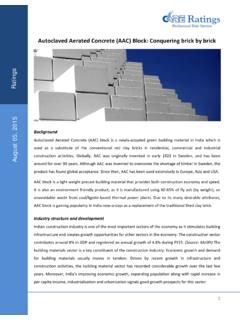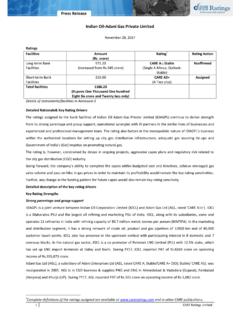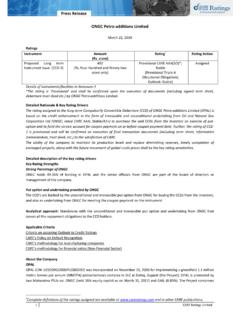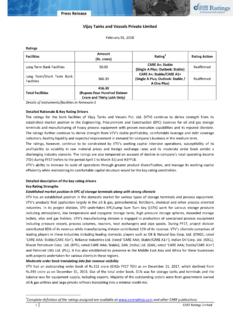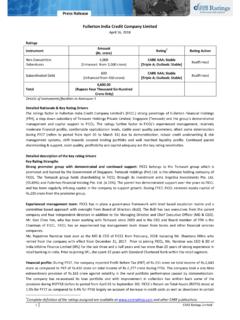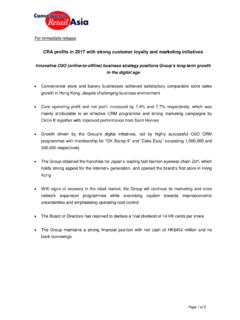Transcription of June 2, 2017 I Industry Research y - Structure & …
1 The Indian retail Industry has emerged as one of the most dynamic and fast-growing industries due to the entry of several new players in the recent times along with rising income levels, growing aspirations, favourable demographics and easy credit availability. It constitutes over 10% of the country s Gross Domestic Product (GDP) and around 8% of the employment and is valued at USD 672 billion.
2 Globally, India is fifth-largest global destination in the retail space and is growing at a rate of 12% per annum. Over the last two decades, the size, scope and complexity of retailing has undergone considerable change. The retail Industry can broadly be classified into two categories: Organized and Unorganized. Organised retail is characterised by high investment requirements, large premises, trained staff where retailers are licensed and are registered to pay taxes to the government.
3 Unorganized retail refers to the traditional form of retail often situated near residential areas. It is generally characterized by low rentals, low tax payouts with a majority of it being owner-managed and employing personal capital. It includes formidable mix of conventional Kirana shops, general stores, mom-&-pop stores, paan-beedi shops and other small retail outlets. Currently, organised retail market is valued at about USD 60 billion, only about 9% of the sector, where as unorganized retail market holds the rest.
4 India's organised retail penetration is much lower compared with other countries, such as the United States which has organised retail sector penetration of 85%. Overview: The word ' retail ' has been derived from the French word 'retailer' which means 'to cut a piece off' or 'to break bulk'. Retailing can be defined as procurement of varied products in large quantities from various sources/manufacturers and their sale in small lots, for direct consumption to the purchaser.
5 Retailing is one of the biggest sectors in India and has witnessed multi fold growth post liberalization of the Indian Economy. The June 2, 2017 I Industry Research Indian retail Industry - Structure & Prospects Contact: Madan Sabnavis Chief Economist 91-22-67543489 Darshini Kansara Research Analyst 91-22-67543679 Mradul Mishra (Media Contact) 91-22-67543515 Disclaimer: This report is prepared by Credit Analysis & Research Limited [CARE Ratings]. CARE Ratings has taken utmost care to ensure accuracy and objectivity while developing this report based on information available in public domain.
6 However, neither the accuracy nor completeness of information contained in this report is guaranteed. CARE Ratings is not responsible for any errors or omissions in analysis/inferences/views or for results obtained from the use of information contained in this report and especially states that CARE (including all divisions) has no financial liability whatsoever to the user of this report. Industry Research I retail Industry 2 evolution of retail trade in India can be traced to the times when majority of trade was routed through formats such as Haats, Mandis and Melas.
7 Mostly organised on a periodical basis and limited to a particular locality/village, such formats gained prominence. Almost everything from vegetables, household necessities to cattle s were bought and sold, either through monetary means or the barter system. Contemporary organised retail Industry evolution in India can be broadly classified in four phases; Chart 1: Evolution of retail in India Source: IBEF 1. Initiation (Pre 1990) Migration of people from villages to urban areas Opening up of small stores for necessity items Advantage of acquaintance with the customers thereby resulting in repeat sales However, limited customer base within locality During the period 1960s to 1980s, domestic textile majors ventured into retailing via company-owned outlets.
8 Few manufactures opened their own outlets such as Vimal, Bombay Dyeing, Raymond s, etc. Footwear makers such as Bata and Metro also established their own chains of retail stores. 2. Conceptualisation (1990-2005) With liberalisation and opening up of Indian economy during the early 1990s, many corporates and first generation entrepreneurs entered retail business and investments by international retail firms increased in India. For the RPG group launched Spencer s in Bangalore in 1991. During the same year, The Raheja s, launched Shoppers Stop in Mumbai.
9 In 1998, Tata group entered the retail business with the brand Westside. Brands like McDonalds, Adidas, Reebok, Nike, Levi Strauss, Lee, Wrangler, Louis Philippe, Pepe Jeans, etc. entered Indian retail market. Growth in apparel retail format was the most significant during this period. 3. Expansion (2005-2010) This period was marked by the growing share of organised retail in the total Indian retail sales pie with substantial investments by large Indian corporates. Pantaloons retail (now Future retail ) opened Home town and E-zone in 2006.
10 Reliance entered the retail business with Reliance fresh in 2006. Besides the above, in the year 2006, government changed the FDI policy by allowing foreign retailers to acquire 51% stake in JV with an Indian firm. This saw several premium brands such as Armani, Versace etc entering the Indian market. During the period 2008-2009, due to recessionary impact seen in the Indian economy, many over-leveraged retail stores had to shut down. 4. Consolidation & growth (2010 onwards) With intense competition in the urban market, retailer started to setup shops in the smaller cities and rural areas.

